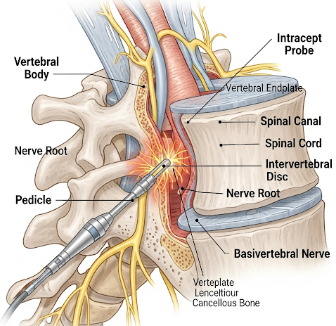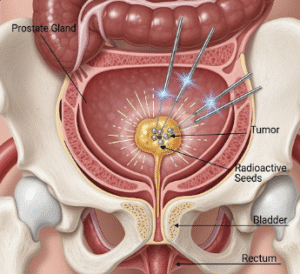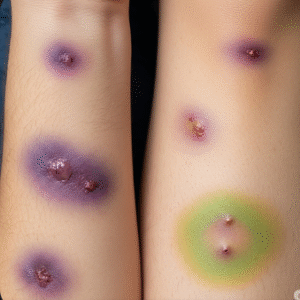Overview
The Intracept Procedure, also known as Basivertebral Nerve Ablation (BVNA), is a minimally invasive treatment for chronic lower back pain originating from vertebral endplates. This procedure targets the basivertebral nerve, which transmits pain signals from degenerative vertebral discs, particularly in patients with Modic changes seen on MRI.
South Korea is renowned for advanced spine care, interventional radiology, and minimally invasive pain management, making it a preferred destination for patients seeking safe, effective, and long-lasting relief from chronic vertebrogenic back pain.
What is the Intracept Procedure?
The Intracept Procedure involves:
- Ablation of the basivertebral nerve within the vertebral body
- Minimally invasive access through a small incision in the back
- Radiofrequency energy delivery to disrupt pain signaling
- Performed under imaging guidance (fluoroscopy or CT) for precise targeting
Indications include:
- Chronic low back pain lasting more than 6 months
- Degenerative disc disease with Modic type 1 or 2 changes
- Failed conservative treatments such as physiotherapy, medications, or injections
- Patients seeking to avoid open spine surgery
What are the Benefits?
- Targeted pain relief → Directly interrupts vertebral pain signaling
- Minimally invasive → Small incision, minimal tissue disruption, lower infection risk
- Short procedure and recovery time → Outpatient or same-day discharge possible
- Durable results → Long-term reduction in chronic back pain
- Improved function and quality of life → Enhanced mobility and activity levels
- Expert care in Korea → High success rates with precision imaging and spine specialists
Procedure Details
1) How should I prepare for the Intracept Procedure?
- Pre-procedure evaluation → MRI or CT scans to confirm Modic changes and pain source
- Medical history review → Assess comorbidities, medications, and previous spine surgeries
- Fasting → 6–8 hours if sedation or anesthesia is planned
- Pre-procedure consultation → Discuss the procedure, expected outcomes, risks, and post-procedure care
- Lifestyle adjustments → Avoid smoking, maintain hydration, and prepare for mild post-procedure activity restrictions
2) What happens during the procedure?
- Anesthesia → Local anesthesia with conscious sedation or general anesthesia if needed
- Patient positioning → Prone (lying face down) on the procedure table
- Imaging guidance → Fluoroscopy or CT used to locate the target vertebral bodies
- Ablation steps →
- Small incision made in the back
- Cannula inserted into the vertebral body to reach the basivertebral nerve
- Radiofrequency probe delivers energy to ablate the nerve
- Ablation confirmed via imaging for precise targeting
- Duration → Typically 60–90 minutes for multiple levels
- Monitoring → Vital signs monitored throughout, with continuous pain and nerve protection
3) What happens after the Intracept Procedure?
- Immediate recovery → Observation for 1–2 hours post-procedure
- Hospital stay → Often outpatient; some patients may stay overnight if needed
- Activity restrictions → Avoid heavy lifting, bending, or twisting for 1–2 weeks
- Pain management → Mild analgesics may be prescribed; most patients experience gradual improvement
- Follow-up visits → Assess pain relief, mobility, and spinal healing
- Rehabilitation → Gentle physiotherapy may be recommended for posture, core strengthening, and spine support
Risks / Benefits
Risks
- ➤ Temporary soreness or bruising at the incision site
- ➤ Numbness or tingling in nearby areas (rare)
- ➤ Infection at incision or vertebral site (rare due to minimally invasive approach)
- ➤ Bleeding or hematoma formation
- ➤ Rare nerve injury or worsening pain
Benefits
- ➤ Minimally invasive, targeted relief of chronic vertebrogenic back pain
- ➤ Rapid recovery with outpatient procedure
- ➤ Durable pain reduction and improved quality of life
- ➤ Avoidance of open spine surgery and associated complications
- ➤ High precision using imaging guidance in Korea
Recovery and Outlook
- Immediate recovery → Mild soreness; patients can usually walk and perform light activities the same day
- Short-term follow-up → Pain may gradually decrease over 2–6 weeks
- Return to normal activity → Most patients resume daily activities within 1–2 weeks; exercise and physiotherapy may be recommended
- Long-term outcomes → Significant reduction in chronic vertebrogenic pain, improved mobility, and enhanced function
- Post-procedure care → Monitor for signs of infection, gradual increase in activity, and follow-up imaging if needed
South Korea provides comprehensive post-procedure monitoring, physiotherapy, and multidisciplinary spine care to ensure optimal recovery and long-term pain relief.
When To Call the Doctor
Contact your spine specialist if you notice:
- ⚠️ Severe or worsening back pain
- ⚠️ Fever, chills, or signs of infection at the incision site
- ⚠️ Numbness, weakness, or tingling in the legs
- ⚠️ Difficulty controlling bladder or bowel function
- ⚠️ Unexpected swelling or bleeding at the procedure site
Best Korea Option / Process
South Korea is a leading destination for Intracept Procedure (BVNA) due to:
- Expert spine surgeons and interventional radiologists
- Advanced imaging-guided minimally invasive techniques
- Comprehensive outpatient and rehabilitation programs
- High success rates with minimal complications
- International patient services → Consultation, language support, coordination, and follow-up
Top Hospitals for Intracept Procedure in Korea:
- Asan Medical Center, Seoul – Advanced spine interventions and chronic back pain management
- Samsung Medical Center – Precision BVNA with multidisciplinary care
- Seoul National University Hospital (SNUH) – Integrated imaging-guided spine care and rehabilitation
- Yonsei Severance Hospital – Expert minimally invasive procedures with post-procedure support
👉 For patients suffering from chronic vertebrogenic lower back pain, the Intracept Procedure in Korea offers a minimally invasive, precise, and highly effective treatment with expert post-procedure care and long-term pain relief.













